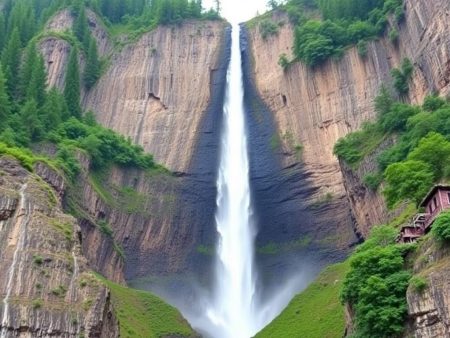Der höchste Berg Nordamerikas thront über der rauen Wildnis Alaskas und ist ein Anblick, der Abenteurer und Naturliebhaber in Ehrfurcht versetzt. Der majestätische Gipfel, bekannt als Denali, erhebt sich auf erstaunliche 20.310 Fuß und ist damit nicht nur ein geografisches Wunder, sondern auch ein Symbol für die ungezähmte Schönheit des Kontinents.
Denali ist nicht nur wegen seiner Höhe ein Ort der Inspiration und Herausforderung. Cli
Denali: Erkundung des höchsten Bergs Nordamerikas und seiner faszinierenden Wunder
Der höchste Berg Nordamerikas thront über der rauen Wildnis Alaskas und ist ein Anblick, der Abenteurer und Naturliebhaber in Ehrfurcht versetzt. Der majestätische Gipfel, bekannt als Denali, erhebt sich auf erstaunliche 20.310 Fuß und ist damit nicht nur ein geografisches Wunder, sondern auch ein Symbol für die ungezähmte Schönheit des Kontinents.
Konvertieren Sie die Größe der größten Menschen, Gebäude, Berge und Denkmäler in m, Fuß und Zoll, um zu vergleichen
0' 0" entspricht 0,0 cm oder 0,00 m.
Denali ist nicht nur wegen seiner Höhe beeindruckend – es ist ein Ort der Inspiration und Herausforderung. Kletterer aus aller Welt werden von seinen eisigen Hängen und seinem unberechenbaren Wetter angezogen, während andere seine Erhabenheit aus der Ferne bewundern. Ob Sie ein begeisterter Bergsteiger sind oder einfach nur neugierig auf die Wunder der Natur, Denali ist ein Beweis für die Kraft und Schönheit der Natur.
Überblick über den höchsten Berg Nordamerikas
Denali, früher bekannt als Mount McKinley, ist mit 20.310 Fuß über dem Meeresspiegel der höchste Gipfel Nordamerikas. Er liegt in Süd-Zentral-Alaska und ist das Herzstück des Denali-Nationalparks und -Reservats. Sein Name stammt vom Volk der Koyukon Athabasken und bedeutet „Der Hohe“.
Dieser massive Gipfel ist Teil der Alaska Range, einer 400 Meilen langen Gebirgskette. Denali ist unübertroffen markant, mit einer Höhe von über 18.000 Fuß von der Basis bis zum Gipfel ist er eine der höchsten Erhebungen der Erde. Die umliegenden Gletscher bedecken etwa 161 TP3T des Parks, wobei der Kahiltna-Gletscher 44 Meilen lang ist – der längste in der Region.
Zu den extremen Wetterbedingungen des Denali gehören Temperaturen unter Null und Windgeschwindigkeiten von über 240 km/h. Diese Elemente stellen selbst für erfahrene Bergsteiger eine gewaltige Herausforderung dar. Trotz der Schwierigkeiten versuchen jedes Jahr mehr als 1.000 Bergsteiger, den Denali zu besteigen, mit einer durchschnittlichen Erfolgsquote von 50%.
Das Ökosystem des Berges bietet Lebensraum für vielfältige Wildtiere wie Karibus, Grizzlybären und Steinadler. Die Tundra- und Taigalandschaften rund um Denali bilden einen markanten Kontrast zu den schneebedeckten Gipfeln und zeigen die reiche Artenvielfalt der Gegend.
Denali: Der majestätische Gipfel
Denali ist mit 20.310 Fuß der höchste Berg Nordamerikas. Seine beeindruckende Präsenz und natürliche Schönheit machen ihn zu einem Mittelpunkt der Erkundung und Bewunderung.
Lage und Geographie
Denali liegt im südlichen Zentralalaska, im Denali-Nationalpark und -Reservat. Es liegt in der Alaska Range, einer 400 Meilen langen Bergkette, die sich über den südlichen Teil des Staates erstreckt. Der massive Anstieg des Berges von der Basis bis zum Gipfel von über 18.000 Fuß trägt zu seiner Erhabenheit bei und macht ihn zu einem der markantesten Gipfel weltweit. Gletscher wie der 44 Meilen lange Kahiltna-Gletscher umgeben Denali, während die Landschaften der Region von Tundra bis zu dichten Taigawäldern reichen.
Höhe und Erhebung
Denali liegt auf einer atemberaubenden Höhe von 20.310 Fuß über dem Meeresspiegel. Er weist auch eine der höchsten Erhebungen der Erde auf und übertrifft sogar den Mount Everest in seiner vertikalen Höhe. Aufgrund seiner extremen Höhe und der kalten Temperaturen ist der Gipfel oft schneebedeckt. Bergsteiger berichten häufig von Herausforderungen, die sich aus der steilen Topographie und der großen Höhe des Berges ergeben, die den Sauerstoffgehalt erheblich beeinflussen.
Wetter- und Klimabedingungen
Das Wetter in Denali ist geprägt von extremer Kälte, starken Winden und raschen Wetterwechseln. Im Winter können die Temperaturen unter -75 °F fallen, wobei der Windchill -118 °F erreicht, während die Sommerbedingungen rau bleiben und in höheren Lagen Durchschnittstemperaturen nahe dem Gefrierpunkt liegen. Die Windgeschwindigkeiten überschreiten oft 150 mph, insbesondere auf dem Gipfel. Diese extremen Bedingungen machen Denali sowohl unberechenbar als auch zu einem der anspruchsvollsten Berge für Bergsteiger weltweit.
Geschichte und kulturelle Bedeutung
Denali hat eine tiefgreifende historische und kulturelle Bedeutung und symbolisiert natürliche Erhabenheit und die menschliche Verbindung zur Wildnis. Sein Erbe ist mit einheimischen Traditionen und modernen Debatten verflochten und spiegelt seine facettenreiche Identität wider.
Indigene Verbindung
Indigene Völker, insbesondere die Koyukon Athabaskans, verehren Denali seit Jahrhunderten. Sie nannten ihn „Denali“, was „Der Hohe“ bedeutet und seinen heiligen Status betont. Der Berg spielt eine wichtige Rolle in ihren mündlichen Überlieferungen und spirituellen Praktiken, die oft mit Schöpfungsmythen und Ehrfurcht vor dem Land in Verbindung gebracht werden. Für die Koyukon und andere Ureinwohner Alaskas verkörpert Denali eine Verbindung zu den Vorfahren und ihren tiefen Respekt vor der Natur und ist ein wesentlicher Bestandteil ihrer kulturellen Identität und ihres Erbes.
Namenskontroverse
Der Name des Berges löste einen langen Streit aus, der auf historischen und regionalen Perspektiven beruhte. 1896 nannte ihn ein Goldsucher Mount McKinley, um den damaligen Präsidentschaftskandidaten William McKinley zu ehren, obwohl er keinerlei Verbindung zu Alaska hatte. Dieser Name ersetzte „Denali“ in offiziellen Aufzeichnungen, was zu Spannungen zwischen indigenen Namenstraditionen und der bundesstaatlichen Anerkennung führte. Im Jahr 2015, nach jahrzehntelangem Einsatz von Ureinwohnern Alaskas und Staatsführern, gab das US-Innenministerium den Namen Denali offiziell zurück, um den Respekt für die Ureinwohner der Region und ihr kulturelles Erbe zu symbolisieren.
Denali besteigen
Den Denali, den höchsten Berg Nordamerikas, zu besteigen, ist eine Herausforderung, die körperliche Ausdauer, mentale Stärke und die richtige Vorbereitung erfordert. Die raue Umgebung und die technischen Anforderungen stellen selbst erfahrene Bergsteiger auf die Probe.
Herausforderungen und Risiken
Die extremen Wetterbedingungen am Denali bergen erhebliche Risiken. Die Temperaturen können bis auf -40 °F fallen und die Windgeschwindigkeiten überschreiten oft 240 km/h, was Erfrierungen und Unterkühlung zur Folge hat. Der niedrige Sauerstoffgehalt in höheren Lagen verstärkt die Schwierigkeiten und erhöht das Risiko einer Höhenkrankheit. Die steilen Hänge und Gletscherspalten des Berges erfordern fortgeschrittene technische Fähigkeiten wie Spaltenbergung und Seilklettern. Lawinen, plötzliche Stürme und wechselnde Schneebedingungen verstärken diese Gefahren zusätzlich und machen den Aufstieg unvorhersehbar.
Beliebte Kletterrouten
Die West Buttress Route ist der beliebteste Weg und zieht etwa 901 TP3T Kletterer an. Sie bietet einen technisch weniger anspruchsvollen Aufstieg, erfordert aber Gletscherwanderungen und die Fähigkeit, mit eisigem Gelände umzugehen. Die Route beginnt am Kahiltna-Gletscher und umfasst bemerkenswerte Abschnitte wie den Motorcycle Hill und das 16.200 Fuß hohe High Camp.
Die weniger frequentierte Muldrow-Gletscherroute bietet eine geschichtsträchtige Alternative, da sie 1913 die erste Besteigungsroute darstellte. Im Gegensatz zum West Buttress erfordert diese Route eine längere Wanderung durch Tundra und Wälder, die viel Ausdauer und Navigationsfähigkeiten erfordert. Andere Routen, wie die Cassin Ridge, sprechen erfahrene Kletterer an, die hochtechnische und vertikale Aufstiege suchen.
Flora und Fauna rund um Denali
Das Ökosystem des Denali-Nationalparks beherbergt eine vielfältige Flora und Fauna, die an die rauen alpinen und subarktischen Bedingungen angepasst ist. Diese Arten gedeihen in verschiedenen Landschaften, darunter Tundra, Taiga und boreale Wälder, und bilden eine reiche biologische Vielfalt im Denali-Nationalpark.
Flora in der Nähe von Denali
Niedrig wachsende Pflanzen dominieren die alpine Tundra, wo kalte Temperaturen und kurze Vegetationsperioden die Vegetationshöhe begrenzen. Polsterpflanzen, Flechten und Moose bedecken felsige Hänge, während Seggen und Gräser in feuchteren Gebieten gedeihen. In niedrigeren Höhenlagen gibt es in den Taigawäldern robuste Arten wie Weißfichten, Schwarzfichten und Birken. Im Sommer verleihen Wildblumen wie Weidenröschen, Lupinen und Zwerg-Hartriegel der Landschaft leuchtende Farben.
Fauna im Denali
Denali ist in seinen vielfältigen Lebensräumen die Heimat typischer nordamerikanischer Wildtiere. Große Säugetiere wie Grizzlybären, Elche und Karibus ziehen frei umher, während Wölfe auf dem weitläufigen Gelände des Parks jagen. Dall-Schafe bewohnen steile Felsklippen und nutzen ihre Wendigkeit, um Raubtieren zu entgehen. Vögel wie Steinadler, Gerfalken und Schneehühner sind ebenso weit verbreitet wie Zugvögel wie Kanadakraniche. Kleinere Säugetiere wie arktische Ziesel und Schneeschuhhasen tragen zum ökologischen Gleichgewicht der Region bei.
Ökosystemdetails
In dieser artenreichen Umgebung herrschen voneinander abhängige Beziehungen zwischen den Arten. Grizzlybären und Wölfe kontrollieren die Beutepopulationen und sorgen für die Gesundheit des Ökosystems. Einheimische Pflanzen bieten Nahrung und Schutz für Pflanzenfresser und Insekten. Trotz des extremen Klimas gedeihen die Flora und Fauna von Denali durch natürliche Anpassung und Widerstandsfähigkeit und zeigen die Kraft des Lebens in rauen Wildnisgebieten.
Abschluss
Denali ist ein Zeugnis der Erhabenheit der Natur und bietet eine unvergleichliche Mischung aus atemberaubender Schönheit, kultureller Bedeutung und ökologischer Vielfalt. Seine gewaltige Präsenz, sein anspruchsvolles Gelände und seine reiche Geschichte machen ihn zu einer Quelle der Faszination für Abenteurer, Naturliebhaber und Historiker gleichermaßen.
Egal, ob man den Denali aus der Ferne bewundert oder aus der Nähe erkundet, erweckt er immer noch Ehrfurcht und Respekt und erinnert alle an die anhaltende Kraft und das Wunder der Natur.
Häufig gestellte Fragen
Wie hoch ist Denali und wie ist er im Vergleich zum Mount Everest?
Denali liegt 20.310 Fuß über dem Meeresspiegel und ist damit der höchste Berg Nordamerikas. Seine vertikale Erhebung von der Basis bis zum Gipfel übertrifft die des Mount Everest und bietet einen der größten Höhenunterschiede der Erde.
Wo liegt Denali?
Denali liegt im südlichen Zentralalaska, im Denali-Nationalpark und -Reservat. Es ist Teil der Alaska Range, einer 400 Meilen langen Bergkette.
Warum ist Denali historisch bedeutsam?
Denali hat eine kulturelle Bedeutung für das Volk der Koyukon Athabasken, das ihn als „The High One“ verehrt. Sein ursprünglicher Name wurde 2015 wiederhergestellt, um das indigene Erbe und kulturelle Vermächtnis anzuerkennen.
Mit welchem Wetter können Bergsteiger auf dem Denali rechnen?
Zu den klimatischen Bedingungen am Denali zählen Temperaturen unter Null, Windgeschwindigkeiten von über 240 km/h und rasche Wetterwechsel, was ihn zu einem der anspruchsvollsten Berge für Bergsteiger macht.
Wie hoch ist die Erfolgsquote beim Besteigen des Denali?
Ungefähr 1.000 Bergsteiger versuchen jedes Jahr den Denali zu besteigen, die Erfolgsquote liegt bei etwa 50%. Bergsteiger müssen auf extreme Wetterbedingungen und technische Herausforderungen vorbereitet sein.
Welche ist die beliebteste Kletterroute am Denali?
Die West Buttress Route ist die beliebteste und wird von etwa 901 TP3T Kletterversuchen geklettert. Sie ist für ihre Zugänglichkeit bekannt, erfordert aber dennoch fortgeschrittene Fähigkeiten.
Wie unterstützt das Ökosystem Denali die Tierwelt?
Das Ökosystem des Denali besteht aus Tundra, Taiga und Gletschern und bietet Lebensraum für Tiere wie Grizzlybären, Elche, Karibus, Wölfe und Steinadler. Es zeigt, wie das Leben trotz rauer Bedingungen gedeiht.
Gibt es Gletscher rund um Denali?
Ja, Denali ist von Gletschern umgeben, darunter auch der 71 Kilometer lange Kahiltna-Gletscher. Rund 161.000 Quadratkilometer der Fläche des Denali-Nationalparks sind mit Eis bedeckt.
Welche Pflanzen wachsen im Denali?
In der Tundra des Denali-Nationalparks finden sich niedrig wachsende Pflanzen wie Flechten, Moose und Polsterpflanzen, während in den Wäldern der Taiga Fichten, Birken und leuchtende Sommerwildblumen wie Weidenröschen und Lupinen wachsen.
Welche Bedeutung hat Denali für die indigene Bevölkerung?
Denali ist für das Volk der Koyukon Athabasken heilig, das seine Majestät seit Jahrhunderten verehrt. Es symbolisiert ihre tiefe Verbundenheit mit dem Land, die sich in ihren mündlichen Überlieferungen und spirituellen Traditionen widerspiegelt.





